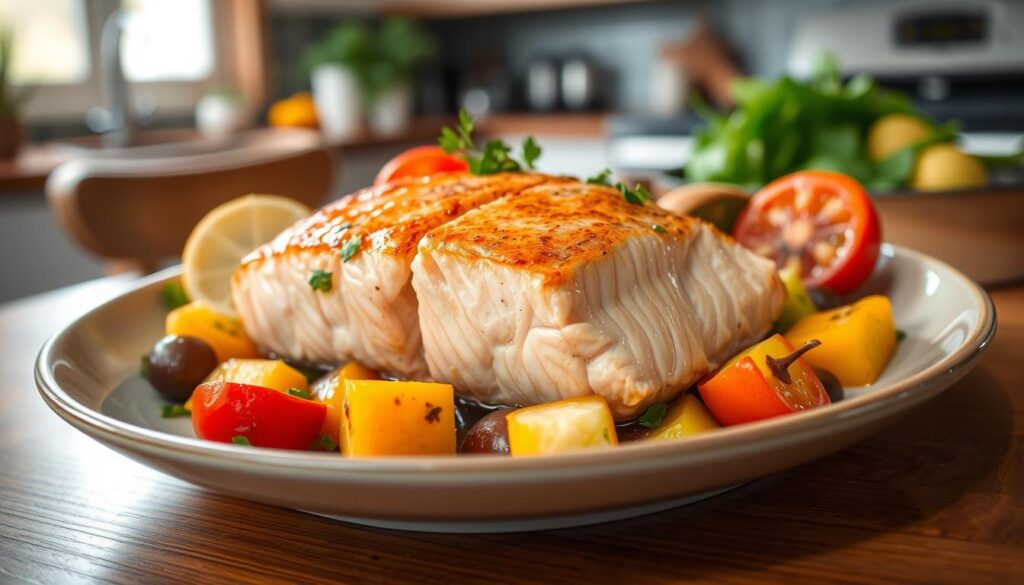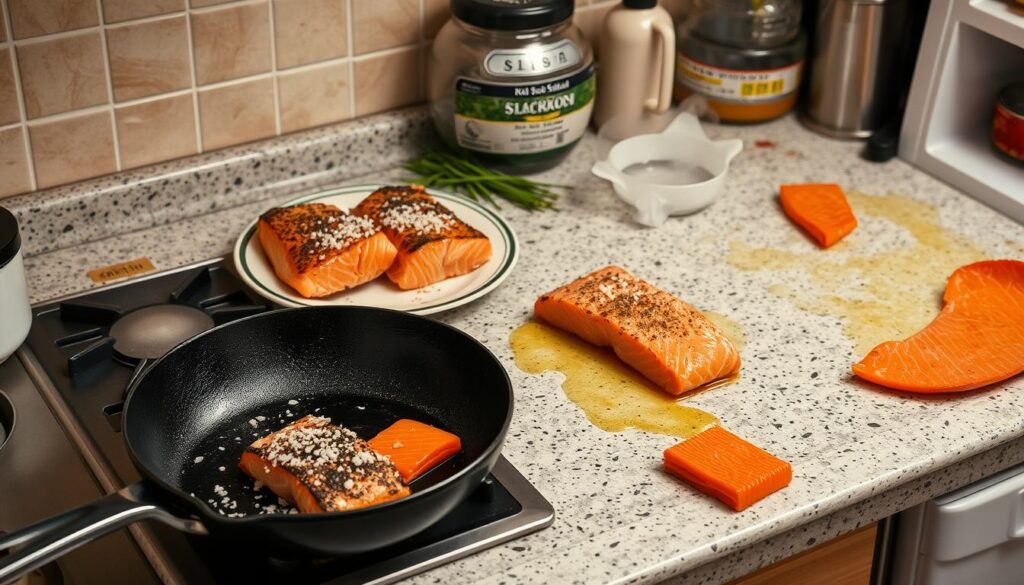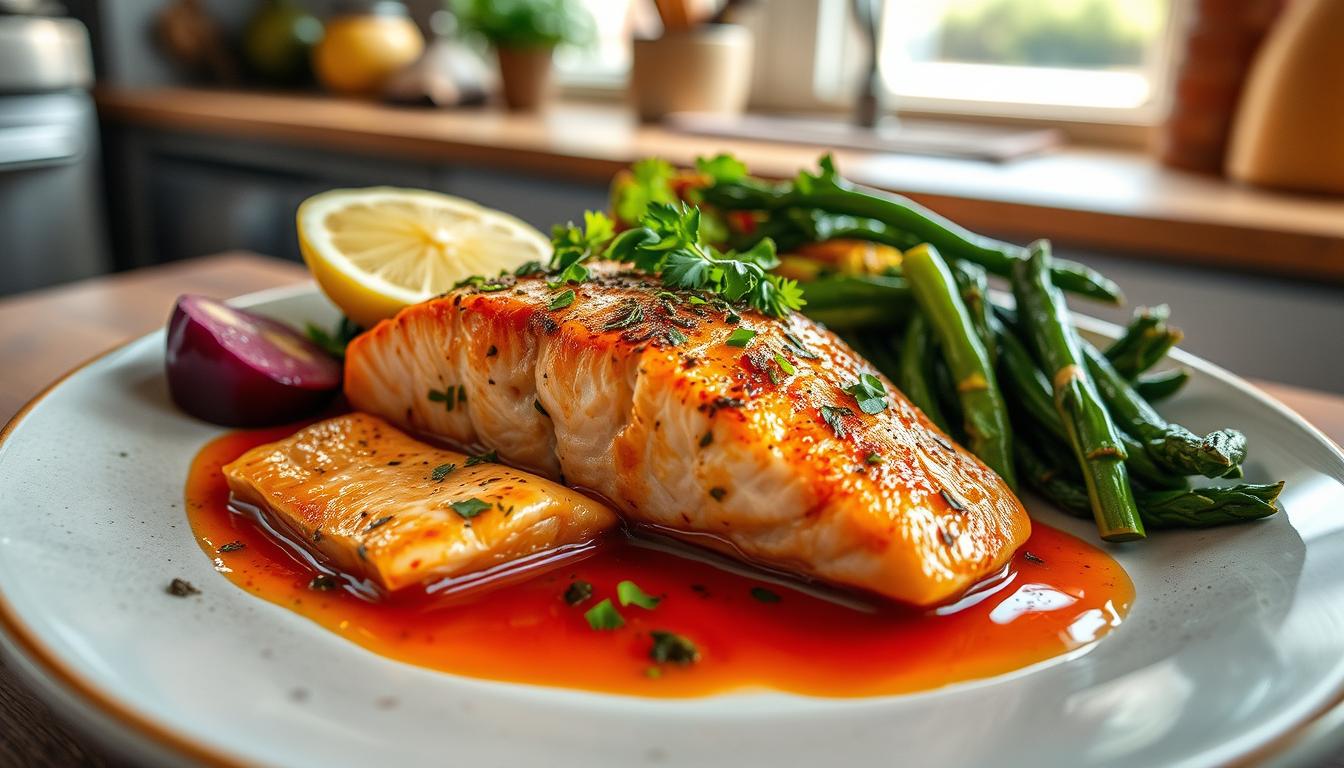Imagine you’re in your kitchen, and the smell of king salmon fills the air. You’re about to cook it for your loved ones. Cooking king salmon is not just about food; it’s about making memories. It’s a celebration of life’s special moments.
With its rich texture and vibrant taste, king salmon is more than a meal. It’s a way to connect with others. In this guide, you’ll learn expert tips to cook king salmon perfectly. Every bite will be a delight for your senses and good for your body.
Whether you’re trying a new recipe or want to master cooking king salmon, we’ve got you covered. We’ll explore techniques to make your kitchen a culinary paradise. You’ll learn about its nutritional benefits, how to choose the freshest cuts, and the right seasonings. These tips will help you create dishes that excite your taste buds and earn praise.
Key Takeaways
- King salmon boasts high-fat content, contributing to its rich, buttery texture.
- The ideal internal temperature for cooked salmon is 145°F, ensuring safety and quality.
- Even cooking is vital; individual portions of around 6 ounces are recommended.
- Cooking salmon in the oven at 425°F for approximately 15 minutes retains moisture.
- Proper storage in an airtight container can preserve cooked salmon for up to 3 days.
Understanding King Salmon: The Premium Choice
King Salmon, also known as Chinook salmon, is a top choice among premium fish. It’s celebrated for its unique qualities and nutritional benefits. This makes it a favorite among seafood lovers.
Nutritional Benefits of King Salmon
King Salmon is known for its high oil content, giving it a rich, melt-in-your-mouth texture. It’s packed with omega-3 fatty acids, which are good for your heart. A serving of king salmon also provides high-quality protein and essential vitamins like D and B12.
It has a very low glycemic index. This means it can fit into many healthy eating plans.
Flavor Profile and Characteristics
The flavor of king salmon is unique, with a rich, buttery taste and mild undertones. It’s more indulgent than other salmon types because of its higher fat content. This makes it great for various cooking methods, like grilling, baking, or pan-searing.
Preparing King Salmon for Cooking
Getting your king salmon ready is key to a great meal. Knowing how to prepare it right sets the stage for a wonderful dining experience. Focus on choosing the right cut, checking for freshness, and picking the best marinades and seasonings.
Choosing the Right Cut
When picking king salmon, choosing the right cut is crucial. Look for fillets that are glossy and firm. They should be about 1¼ inches thick for the best cooking. If you can find it, white king salmon is a rare but tasty choice.
A standard serving size is 6 ounces per person. This size ensures everyone gets a good portion. Enjoy the delicate, tender flakes that this premium fish offers.
Freshness Indicators to Look For
Checking for freshness is important. Fresh king salmon should smell like the ocean, not strongly fishy. Look for bright, clear eyes and vibrant skin. Avoid dull spots or discoloration, as they may mean the fish has been sitting too long.
Always buy salmon from trusted sources that focus on quality.
Essential Marinades and Seasonings
Seasoning king salmon right can make it even more delicious. Use marinades like olive oil, lemon juice, garlic, and herbs like dill or parsley. Dry brining the salmon for at least 30 minutes, or overnight, can improve both texture and flavor.
By following these tips, your king salmon will not only be cooked well but also full of flavor.
Various Cooking Methods for King Salmon
Exploring different king salmon cooking techniques makes cooking more fun. Each method brings out unique flavors and textures. This lets you choose the best way to cook king salmon that suits your taste.
Grilling: Achieving Perfect Grill Marks
Grilling kings salmon adds a smoky flavor and gives you perfect grill marks. Cook it for 4-6 minutes on each side over medium-high heat. This method adds a char that enhances the fish’s natural richness.
Baking: Time and Temperature Guidelines
Baking is easy and keeps the salmon moist. Preheat your oven to 375°F (190°C). Bake for 15-20 minutes until it flakes easily with a fork. This method ensures a tender and delicious result.
Pan-Searing: For a Crispy Finish
Pan-searing gives a crispy exterior. Start by cooking the salmon skin-side down for 4-5 minutes. Then, flip it and cook for another 3-4 minutes until it’s perfectly cooked inside. This technique offers a great contrast between the crisp skin and juicy meat.
Poaching: A Gentle Cooking Technique
Poaching is great for keeping the salmon’s delicate texture. It takes about 10-12 minutes until the salmon is opaque and flakes easily. Poaching keeps the fish moist, making it perfect for lighter dishes.
| Cooking Method | Time | Temperature | Remark |
|---|---|---|---|
| Grilling | 4-6 minutes per side | Medium-high heat | Best for smoky flavor and grill marks |
| Baking | 15-20 minutes | 375°F (190°C) | Retains moisture for tenderness |
| Pan-Searing | 4-5 minutes one side, 3-4 minutes after flipping | Medium heat | Crispy skin, juicy inside |
| Poaching | 10-12 minutes | Low simmer | Moist and gentle cooking |
Each method highlights the king salmon in its own way. Whether you choose the grill, oven, or stovetop, you have the best techniques to make every meal a success.
The Importance of Cooking Temperature
Knowing the importance of cooking temperature is key to cooking king salmon right. The internal temperature guidelines help ensure your salmon is safe and tasty. The USDA says to cook it to 145°F to avoid foodborne illnesses.
If you like your salmon medium-rare, aim for 125°F. This is best for wild salmon.
Ideal Internal Temperature for Kings Salmon
The internal temperature is crucial for cooking kings salmon. It affects the texture and moisture of the fish.
- 145°F: Recommended by the USDA for food safety.
- 125°F: Target for medium-rare quality, specially for wild salmon.
- 120°F – 125°F: Acceptable range for carryover cooking, where salmon continues to cook after being removed from heat.
- 135°F: Suitable upper limit for farmed salmon while retaining moisture.
Salmon proteins start to coagulate at 120°F. This is much lower than other meats. Salmon’s unique properties allow for safe, lower cooking temperatures without losing flavor or moisture.
Techniques for Accurate Temperature Measurement
Using the right tools and techniques is key for accurate temperature measurement. Here are some methods:
- Use a reliable meat thermometer: Insert the thermometer into the thickest part of the salmon for the most precise reading.
- Allow for resting time: After cooking, let the salmon rest for 1-2 minutes. This period helps in even heat distribution throughout the fish.
- Adjust for thickness: Remember that thicker portions benefit more from lower temperatures due to increased carryover cooking.

By following these tips, your salmon will be perfectly cooked, safe, and full of flavor. These internal temperature guidelines will improve your cooking skills and make your meals better.
Enhancing Flavor with Complementary Ingredients
Choosing the right ingredients is key to making your king salmon dish stand out. This fish’s rich, buttery texture goes well with many sides and flavor boosters. Look for recipes that let the salmon shine while adding a well-rounded meal.
Best Side Dishes for Kings Salmon
- Roasted Vegetables: Carrots, zucchini, and bell peppers add a sweet touch.
- Lemon Asparagus: Lemon’s acidity cuts through the salmon’s richness.
- Garlic Mashed Potatoes: These are creamy and savory, matching the fish’s texture.
Flavor Pairings: Herbs and Spices
For a better kings salmon dish, try these flavor pairings:
- Garlic: It adds a savory, aromatic flavor, great in marinades or as a seasoning.
- Dill: This herb is fresh and tangy, perfect with fish.
- Capers: Their salty taste contrasts well with the salmon’s natural flavors.
| Side Dish | Flavor Profile | Cooking Method |
|---|---|---|
| Roasted Vegetables | Sweet and earthy | Roasting |
| Lemon Asparagus | Citrusy and bright | Steaming or grilling |
| Garlic Mashed Potatoes | Savory and creamy | Boiling and mashing |
Avoiding Common Mistakes When Cooking Kings Salmon
Cooking kings salmon can be a fun experience. But, to get the best results, you should avoid common mistakes. Two big mistakes are overcooking the fish and not letting it rest after cooking. Both can ruin the fish’s texture and taste.
Overcooking: How to Prevent Dryness
Overcooking salmon makes it dry and unappetizing. The perfect internal temperature for king salmon is between 125°F and 130°F. This ensures it’s medium-rare.
To avoid dryness, use a thermometer to check the temperature. When grilling, keep the heat at medium-high, between 375°F and 400°F. Grill the salmon skin-side down for 6–8 minutes without flipping. Larger pieces might need indirect grilling for 15–20 minutes.
Skipping the Resting Period: Why It Matters
Letting salmon rest after cooking is key for keeping flavors. A 5-minute rest lets the juices spread evenly, making the fish moist and flavorful. This step is often missed but greatly improves your dish.
If you skip the resting time, your salmon might dry out quickly. This can make your meal less enjoyable.

Presentation Ideas to Showcase Your Kings Salmon Dish
Creating a stunning presentation for your Kings Salmon dish makes the meal better. Thoughtful plating and eye-catching garnishes can make your dish look like it’s from a restaurant. Use different presentation tips for salmon dishes to make sure each part of the plate looks good and tastes great.
Plating Techniques for Visual Appeal
When plating your King Salmon, focus on its bright colors and rich texture. Start with a clean plate and try these methods:
- Layering the salmon on top of a base, like sautéed veggies or puree, adds height and interest.
- Using negative space lets the dish breathe and highlights the salmon.
- Place colorful side dishes, like lemon-roasted asparagus or garlic mashed potatoes, around the salmon for a vibrant contrast.
Garnishing Tips for a Restaurant-Quality Look
Garnishing your king salmon makes the plate look better and adds flavor. Here are some garnishing ideas to make your dish pop:
- Sprinkle fresh herbs like dill, parsley, or chives for a burst of green and freshness.
- Place a lemon slice beside the salmon for a splash of color and zesty flavor.
- Drizzle a light sauce, like balsamic reduction or lemon butter, across the plate for flair.
By using these presentation tips for salmon dishes, you can make a plate that will wow your guests. Focus on both the looks and the flavors. Turn your homemade King Salmon into a true culinary masterpiece.
Storing Leftover King Salmon Properly
Storing leftover king salmon right is key to keeping it fresh. Knowing how to store salmon helps keep your meal tasty and safe. This part talks about how to keep it in the fridge and freezer tips, so you can enjoy it later.
Best Practices for Refrigeration
Here’s what to do when storing leftover king salmon in the fridge:
- Use an airtight container to keep moisture in and out of contamination.
- Keep the fridge at 32°F for the best taste.
- Cooked salmon stays good for up to 3 days in the fridge.
Tips for Freezing King Salmon
Freezing is great for longer storage. Here’s how to freeze salmon well:
- Wrap it in plastic wrap and foil to stop freezer burn.
- Freeze at 0°F or lower for best preservation.
- Frozen salmon stays tasty and fresh for up to 3 months.
- Defrost in the fridge and cook within 24 hours.
By following these storage tips, your leftover king salmon will stay delicious. This makes your meals enjoyable now and later.
Health Benefits of Consuming King Salmon
King Salmon is not just tasty; it’s also packed with health benefits. It’s full of nutrients that boost your well-being. Eating King Salmon can help your heart, manage your weight, and improve your nutrition.
Omega-3 Fatty Acids and Heart Health
King Salmon is rich in omega-3 fatty acids, with about 2,200–2,500 mg per 100 grams. These fats are key for heart health. Studies show eating them can cut heart disease risk by up to 30%.
Omega-3s in King Salmon also lower triglycerides by 15-30%. This makes it a great choice for your heart.
Adding fatty fish like King Salmon to your meals supports heart health. It may also reduce inflammation by about 20%.
Role in a Balanced Diet
Eating King Salmon regularly adds vitamins and minerals to your diet. It has about 25 grams of protein per 100 grams. This can help you feel full and might cut your daily calories by 10–15%.
King Salmon is also a good source of vitamin D, with about 570 IU per 100 grams. It supports your immune system. Plus, it has B vitamins and selenium for energy and protection.
| Nutrient | Amount per 100g |
|---|---|
| Omega-3 Fatty Acids | 2,200–2,500 mg |
| Protein | 25 g |
| Vitamin D | 570 IU |
| Vitamin A | 50% more than other fish |
| Selenium | Varies |
Knowing the health benefits of King Salmon helps you make better choices. Add this nutritious fish to your diet to enjoy its many benefits.
Eco-Friendly Choices: Sustainable King Salmon
More people are thinking about how their food choices affect the planet. Choosing sustainable king salmon is a big step towards eco-friendly seafood. It lets you enjoy great taste while helping the environment.
Sourcing Methods for Sustainability
It’s key to know the difference between wild-caught and farmed king salmon. Wild-caught usually has less environmental impact. Look for these certifications to find sustainable sources:
- Marine Stewardship Council (MSC): This ensures the fish comes from sustainable wild-caught fisheries.
- Aquaculture Stewardship Council (ASC): This mark means the fish was farmed responsibly, keeping the environment balanced.
- Global Aquaculture Alliance Best Aquaculture Practices (BAP): This shows the fish was farmed using sustainable methods.
Certifications to Look For
Choosing king salmon with good certifications makes it more sustainable. Here are the top certifications to look for:
| Certification | Focus Area | Importance |
|---|---|---|
| Marine Stewardship Council (MSC) | Wild-caught fisheries | Encourages sustainable fishing practices |
| Aquaculture Stewardship Council (ASC) | Farmed fish | Ensures responsible aquaculture practices |
| Global Aquaculture Alliance BAP | Best aquaculture practices | Promotes environmentally responsible farming |
Conclusion: Mastering the Art of Cooking King Salmon
Mastering king salmon cooking starts with knowing its special qualities. You can grill, bake, or pan-sear it. Always aim for an internal temperature of 125°F for the best taste.
Let your salmon rest for about 5 minutes after cooking. This makes it juicy and full of flavor. It also makes your dish look great.
Adding fresh ingredients like garlic, lemon juice, or soy sauce can make your dish even better. Try different sides and sauces to find the perfect match for your salmon. Every time you cook, you can try something new and exciting.
Cooking king salmon is all about creativity. Use your instincts and enjoy the process. Get your ingredients ready, heat up your skillet, and start cooking with confidence!

